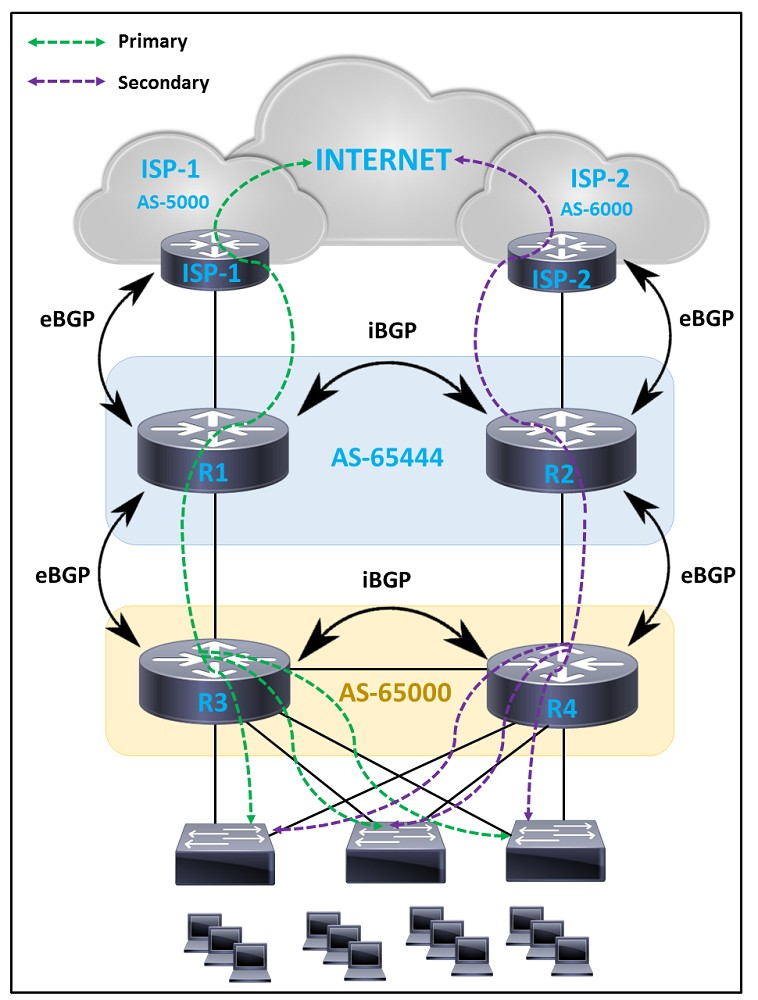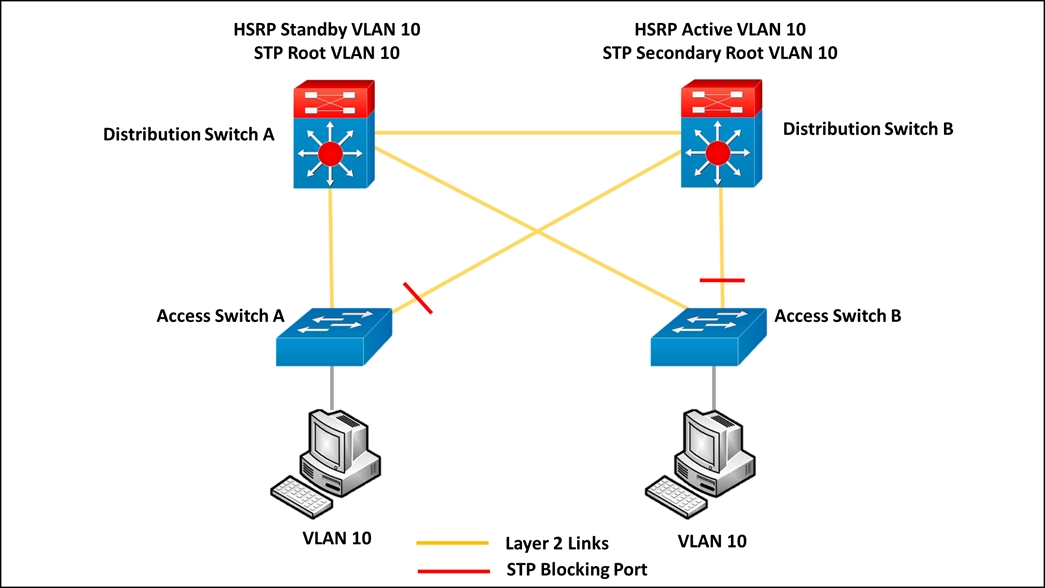Cisco® 300-420 Exam Practice Questions (P. 5)
- Full Access (387 questions)
- One Year of Premium Access
- Access to one million comments
- Seamless ChatGPT Integration
- Ability to download PDF files
- Anki Flashcard files for revision
- No Captcha & No AdSense
- Advanced Exam Configuration
Question #41
Refer to the exhibit.

An engineer must design a WAN solution so that ISP-1 is always preferred over ISP-2. The path via ISP-2 is considered as a backup and must be used only when the path to ISP-1 is down. Which solution must the engineer choose?

An engineer must design a WAN solution so that ISP-1 is always preferred over ISP-2. The path via ISP-2 is considered as a backup and must be used only when the path to ISP-1 is down. Which solution must the engineer choose?
- AR1: - Routes advertised to ISP-1: 0x AS-path prepend - Routes received from ISP-1: HIGH local-preference - Routes advertised to R2: no action - Routes received from R2: community NO-EXPORT R2: - Routes advertised to ISP-2:5x AS-path prepend - Routes received from ISP-2: LOW local-preference - Routes advertised to R1: community NO-ADVERTISE - Routes received from R1: no action
- BR1: - Routes advertised to ISP-1: 0x AS-path prepend - Routes received from ISP-1: HIGH local-preference - Routes advertised to R2: community NO-EXPORT - Routes received from R2: no action R2: - Routes advertised to ISP-2: 5x AS-path prepend - Routes received from ISP-2: LOW local-preference - Routes advertised to R1: no action - Routes received from R1: no action
- CR1: - Routes advertised to ISP-1: 0x AS-path prepend - Routes received from ISP-1: LOW local-preference - Routes advertised to R2: community NO-ADVERTISE - Routes received from R2: no action R2: - Routes advertised to ISP-2: 5x AS-path prepend - Routes received from ISP-2: HIGH local-preference - Routes advertised to R1: no action - Routes received from R1: community NO-ADVERTISE
- DR1: - Routes advertised to ISP-1: 5x AS-path prepend - Routes received from ISP-1: LOW local-preference - Routes advertised to R2: community NO-ADVERTISE - Routes received from R2: no action R2: - Routes advertised to ISP-2: 0x AS-path prepend - Routes received from ISP-2: HIGH local-preference - Routes advertised to R1: community NO-EXPORT - Routes received from R1: no action
Correct Answer:
B
B
send
light_mode
delete
Question #42
Which feature must be incorporated into the campus LAN design to enable Wake on LAN?
- Adynamic ARP Inspection Snooping on layer 2 devices
- Bdirected broadcasts on layer 3 devicesMost Voted
- Cproxy ARP on layer 3 devices
- DDHCP Snooping on layer 2 devices
Correct Answer:
B
B
send
light_mode
delete
Question #43

Refer to the exhibit. An engineer must optimize the traffic flow of the network. Which change provides a more efficient design between the access layer and the distribution layer?
- AAdd a link between access switch A and access switch B
- BReconfigure the distribution switch A to become the HSRP ActiveMost Voted
- CChange the link between distribution switch A and distribution switch B to be a routed link
- DCreate an EtherChannel link between distribution switch A and distribution switch B
Correct Answer:
B
B
send
light_mode
delete
Question #44
Which first hop redundancy protocol ensures that load balancing occurs over multiple routers using a single virtual IP address and multiple virtual MAC addresses?
send
light_mode
delete
Question #45
A company with multiple service providers wants to speed up BGP convergence time in the event a failure occurs with their primary link. Which approach achieves this goal and does not impact router CPU utilization?
- AUtilize BFD and tune the multiplier to 50
- BLower the BGP hello interval
- CDecrease the BGP keepalive timer
- DUtilize BFD and keep the default BGP timersMost Voted
Correct Answer:
C
C
send
light_mode
delete
Question #46
An engineer is designing an enterprise campus network. The LAN infrastructure consists of switches from multiple vendors, and Spanning Tree must be used as a
Layer 2 loop prevention mechanism. All configured VLANs must be grouped in two STP instances. Which standards-based Spanning Tree technology supports this design solution?
Layer 2 loop prevention mechanism. All configured VLANs must be grouped in two STP instances. Which standards-based Spanning Tree technology supports this design solution?
send
light_mode
delete
Question #47
A network engineer must segregate three interconnected campus networks using IS-IS routing. A two-layer hierarchy must be used to support large routing domains and to avoid more specific routes from each campus network being advertised to other campus network routers automatically. Which two actions does the engineer take to accomplish this segregation? (Choose two.)
- ADesignate two IS-IS routers as BDR routers at the edge of each campus, and configure one BDR for all Level 1 routers and one BDR for all Level 2 routers.
- BDesignate two IS-IS routers from each campus to act as Level 1/Level 2 backbone routers at the edge of each campus network.
- CAssign the same IS-IS NET value for each campus, and configure internal campus routers with Level 1/Level 2 routing.
- DUtilize different MTU values for each campus network segment. Level 2 backbone routers must utilize a larger MTU size of 9216.
- EAssign a unique IS-IS NET value for each campus, and configure internal campus routers with Level 1 routing.
Correct Answer:
BE
BE
send
light_mode
delete
Question #48
Which consideration must be taken into account when using the DHCP relay feature in a Cisco SD-Access Architecture?
- ADHCP-relay must be enabled on fabric edge nodes to provide the correct mapping of DHCP scope to the local anycast gateway.
- BA DHCP server must be enabled on the border nodes to allow subnets to span multiple fabric edges.
- CDHCP servers must support Cisco SD-Access extensions to correctly assign IPs to endpoints in an SD-Access fabric with anycast gateway.
- DDHCP Option-82 must be enabled to map the circuit IP option to the access fabric node where the DHCP discover originated.Most Voted
Correct Answer:
A
A
send
light_mode
delete
Question #49
Which function are fabric intermediate nodes responsible for in an SD-Access Architecture?
- Amapping EIDs to RLOCs
- Bencapsulating user traffic in a VXLAN header including the SGT
- Cregistering new endpoints in the HTDB
- Dtransporting IP packets between edge nodes and border nodesMost Voted
Correct Answer:
D
D
send
light_mode
delete
Question #50
How do endpoints inside an SD-Access network reach resources outside the fabric?
- Aa VRF fusion router is used to map resources in one VN to another VN
- BFabric borders use VRFs to map VNs to VRFsMost Voted
- CSD-Access transit links are used to transport encapsulated traffic from one fabric to another
- DA fabric edge is used to de-encapsulate VXLAN traffic to normal IP traffic then transported over the outside network
Correct Answer:
D
D
send
light_mode
delete
All Pages
